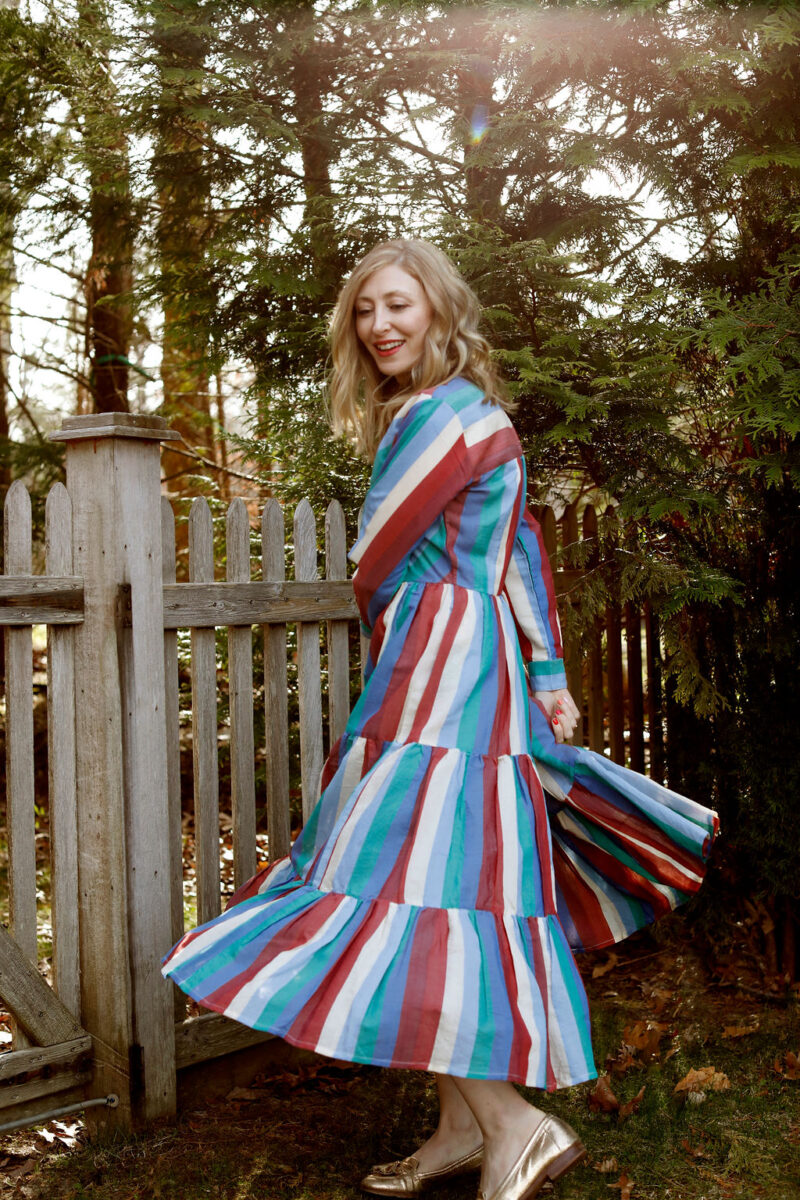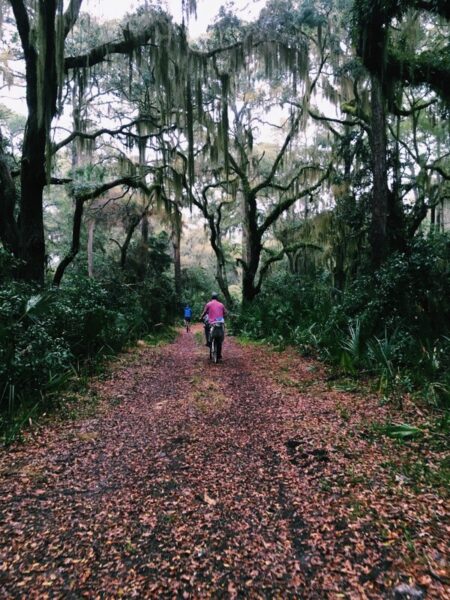5 ways my work has changed my life

When people find out what I do for a living, their first response is often, “You must have such a colorful home!”
And it’s true. My research on joy and design has made my house, my wardrobe, and my life much more vibrant. There’s no doubt that walking in the door to see pops of color and playful objects improves my mood on the daily. But the reality is that these changes are only the tip of the iceberg. My research has changed more than just my home. It’s transformed my whole life.
Because when you know the science about joy, you can’t help but put it into practice.
Some of the research is so clear that it would feel foolish if I didn’t incorporate these ideas into my life.
These are things I wish everybody knew. They feel like essential life skills for living in a human body with human emotions. Sometimes I think about the fact that we spend months in school learning about times tables and state capitals and not a single day on understanding what happens inside our bodies when we feel things, and how we can build a sense of emotional well-being. It’s especially ironic to me because happiness is so often framed as the goal of life. If that’s the case, why are we left all on our own to figure out how to find it?
This question is really at the heart of why I wanted to create a School of Joy: to share evidence-based strategies for building a life that feels good. And this is what we’re doing this fall in a new live series called Reclaim Joy. It’s set of three workshops with creative exercises and tools to help you find resilience, get unstuck and unblocked, and start creating a life you love. You can get all the details and save your seat here.
Without further ado, here are five ways my research on joy has changed my life. I hope they give you some new ways to think about your well-being. And inspire you to do what works for you to put joy at the center of your life.
5 Ways My Work Has Changed My Life
I’ve stopped asking “Am I happy?”
I used to ask myself often if I was happy. I didn’t always know the answer — sometimes things would be going well at work but I’d be in a fight with my boyfriend, or I was excited about a new crush but anxious about it too. Was I happy? It was hard to tell.
One of the first things I learned in my research was that happiness and joy are different things. I know I’m a broken record about this, but it’s such an important distinction that I want to take a moment to pull them apart. Happiness is a broad evaluation of how we feel about our lives over time. It’s made up of a range of factors: how we feel about our health and our work, whether have a sense of meaning and purpose in life, how connected we feel to other people. This explains why sometimes we can’t easily answer the question — happiness is a big concept. And it can be hard to encapsulate the complexity of our lives in one answer.
Joy, on the other hand, is much simpler and more immediate.
Psychologists define joy as an intense, momentary experience of positive emotion. Joy can be measured through direct physical expressions. Like smiling, laughter, or a feeling of wanting to jump up and down. It’s about how good we feel right now, in the moment. It’s the opposite of vague — when we feel a moment of joy, there’s no doubt.
With this distinction clear, I realized that happiness is often a red herring. Thinking about whether I’m happy takes me out of the flow of my life and prompts me to evaluate and compare. Am I happier than I was a year ago? Am I as happy as my friends? That smiling influencer I follow on social media sure looks happy. If I’m not that happy, am I really happy at all? Without a clear benchmark, I find I’m often measuring against some imagined ideal of happiness, and it’s easy for my everyday life to fall short.
But as I began to focus more and more on moments of joy, I noticed that I stopped thinking so much about happiness. On a good day, on a bad day — what if I just focused on finding one more moment of joy? This put me back in my life, and gave me a sense of agency. Yes, my work day was spiraling out of control but if I could go outside and spend five minutes in the sunshine, the day wasn’t wasted. The happy dance I did with Albert at the end of a long week wasn’t a throwaway, but a bonding moment that brought us closer.
What joy teaches us is that the little things are the big things.
A quick kiss in the hallway, taking five minutes to messily write a loved one’s name on a cake, a pause to breathe in the smell of the rain — these moments add up to a joyful life.
Over time, I noticed that the question “Am I happy?” began to feel irrelevant. By savoring and creating moments of joy, I did end up feel happier on a daily basis — and paradoxically, I didn’t need to ask myself about it anymore.
I’m better at handling bad days
A few years ago, a man came up to me after a talk I gave at a large conference. Standing in the Vegas auditorium, he told me he had just been diagnosed with Parkinson’s disease, and that my talk had explained something he hadn’t been able to put into words. “I’m not happy about the diagnosis,” he said, “but I’m still able to feel joy.”
A lightbulb switched on for me. If joy and happiness are distinct, then we can find joy even when we’re unhappy.
Moments of joy are always available to us.
To be clear, this is not the no-bad-vibes, put on a happy face approach of toxic positivity. It’s not about just “choosing joy” like so many Instagram quotes suggest. (Though honestly, I’ve probably posted a couple of those in the past.) This is about recognizing that we can hold multiple emotions at the same time. It’s not all or nothing. I can have a crappy day where all I want to do is bury my head under the covers, and I can delight in my toddler’s giggles as we play “Catch Mom” around the kitchen. These things are not mutually exclusive.
It’s especially important to know the science here. We tend to think of our days as an average of all the stuff that happens to us. So, when a few big bad things happen (car breaks down, kid gets sick, a work meeting goes poorly), small moments of joy seem pointless. They can’t “raise the average,” so why bother even trying? But when the brain makes memories, it’s not taking an average. It’s isolating the most novel and intense memories of the day. So if you can find just a few bright spots in a bad day, your brain will catalog them, and when you look back, the day won’t seem so horrible after all.
Small moments of joy do something else too.
They help stop us from spiraling further downward, and kickstart what researchers call “upward spirals” of well-being. Knowing this, I’m intentional about looking for joy when I feel worries and frustrations starting to pile up on one another. It’s not about erasing the negative feels. I can hold those too. But bringing in a flicker of light helps keep me from that swirling feeling like I’m about to be sucked down the drain.
Note: I shared more evidence-based strategies for healing from hurt, building resilience, and finding buoyancy on hard days in my new workshop How to Thrive in Tough Times: Finding Joy in the Dark, still available as a recording on-demand. Sign up and get the details here.
I have a better balance between living in the present and planning for the future
One thing about happiness, at least in Western culture, is that it’s often associated with big milestones in life. As a result, we spend a lot of time thinking (and wishing and worrying) about the future. We worry about finding a soul mate or being able to buy a house, having a child or getting a promotion.
But all that focus on the future can sometimes shortchange our lives in the present. For example, you might feel you’re doing a good thing by skipping a birthday party or a concert to put in overtime at the office. You might feel virtuous for skipping lunch with a friend so you can save the money for your down payment. Society praises your work ethic and your ability to sacrifice for long-term goals. (Never mentioning, of course, the fact that wealth inequality and systemic injustice have made it almost impossible for those skipped lunches and overtime hours to add up to meaningful financial security.) Meanwhile, you’re rarely prompted to think about what happens to your joy in the present. When those moments are gone, you can’t get them back.
What I’ve realized is that over time we develop the muscle of deferring joy.
We get so good at the sacrifice and the eating at our desks and the sending our regrets and the “Mom can’t play with you now, sweetie” that eventually our present lives become hollowed out. They are a vessel waiting to be filled — but when?
This can become a vicious circle. The more we delay our joy, the less there is to excite us in our present lives, and the more weight we put on the imagined future to deliver our happiness. Now we really need those milestones to deliver for us, because we’ve waited and worked so hard for them. This is the perfect setup for a painful experience of arrival fallacy, the feeling of disappointment we get when we achieve our goal and then realize we still feel like something’s missing.
The only way out of this trap is to reinvest in joy in the present. Plan something to look forward to this week, not next month. Buy a frisbee and go throw it around with a friend or your kids. Go out for ice cream and get the sprinkles. Build routines that carve out time for something you love, right now. When I lived in the city, I used to do this by leaving 15 minutes early for work and using that time to read in a nearby park before going into the office. It was only 15 minutes, but by not waiting all day to do something that brought me joy, I rebuilt my muscle of not waiting to create joy. Because if I did, it truly might never happen.
This isn’t to say I don’t work hard and dream about the future. But that work is less angsty and those dreams less desperate when I allow myself to live in the now.
I’m less judgmental
I was pretty deep into my work on joy before I realized something. My darkest, gloomiest, loneliest periods often coincided with a critical attitude. I’d be feeling left out and behind in life, and then I’d hear myself sniping about so-and-so’s ugly shoes, or a movie I didn’t like. These two things seemed disconnected at first, but as I learned about the way judgment influences joy, I identified a connection.
The judgments we hold about others also pertain to ourselves. So, for example, if we routinely deride other people’s fashion choices, it means we are likely also afraid of being seen as gauche. If we put down another creator’s work, it’s likely that we’re also sensitive to criticism, and worry that others might think us amateurish or unworthy. These judgments usually originate as protective impulses, designed to keep us safe from painful feelings like rejection. But over time, they can isolate us and stifle our joy.
Here’s a specific example
For a long time I was afraid to go out to dinner by myself because I thought it looked pathetic. When I was in a relationship, I often looked at single women out and about in my Brooklyn neighborhood and thought, “How sad. No one wants you.” It’s painful even to admit this, because of course, this is exactly how I felt about myself when I wasn’t in a relationship. I had been so convinced that my desirability to a man was what made me worthy (thank you, patriarchy!) that I projected this judgment onto all the single women I saw.
When I realized this, I began to unravel this judgment. I practiced looking at women doing things by themselves and thinking, “She looks like she’s having fun.” As I did this, eating by myself no longer seemed pathetic. I’d opened up a new source of joy — eating out alone — that had previously been closed off to me, only because of judgment.
Letting go of judgment isn’t an overnight thing. It’s taken work to uncover the sources of my judgments (hint: they’re often related to my biggest fears). But each time I’m able to release some of my harsh opinions of others, I find new space to take risks and be more myself in life.
Note: If you’d like to let go of judgment and make more space for joy, I’ll be sharing tools to do just that in the second workshop in the Reclaim Joy series: How to Get Unstuck: Stop Waiting for Happiness, Start Creating Joy. Sign up and get the details here.
My memories are richer
One of the things I did in JOYFUL was to break down experiences of joy and analyze them. Why do some celebrations seem to sparkle with joy and others fizzle and fall flat? Why is a visit to Disneyland such a universally beloved way to spend a day? Answering these questions isn’t just an academic exercise for me. As a designer, I’m always interested in how we can use these elements to heighten the joy of a place or thing.
It’s like having a toolkit to squeeze more joy out of ordinary moments. This knowledge influences small choices I make on a daily basis. And over time, I’ve been surprised to find that it makes my memories feel bolder and richer.
The research says this makes sense. When creating memories, the brain prioritizes events with higher emotional and sensorial intensity, so if you can amplify the joy in the moment, you also increase the chances of an experience being saved into memory so you can enjoy it again and again.
For example
I never used to decorate much for the holidays, but a few years ago I started really going for it. My decorations aren’t picture perfect but I’m big on enthusiasm, claiming the biggest tree we can fit, and climbing up a ladder to wind twinkle light garlands around the posts on our front porch. Since I’ve started decorating, I’ve found each holiday is much more memorable to me. I remember the year it snowed in November, making the house look like a storybook. I remember lying around last year in a post-Christmas dinner food coma, munching gingerbread and gazing up at the red, orange, and blue lights on the tree.
This principle also changes the way I spend my money.
I don’t necessarily put stock in the idea that you should always spend money on experiences over things (this research on this suggests it’s the opposite for some people), but I do believe in spending on things that are a conduit to joy. So for example, a new cookbook feels like a worthwhile purchase because making new and different recipes will add more texture and variety to my days. It will make ordinary meals more memorable. This is more valuable to me than a beautiful coffee table book (even though I love beautiful coffee table books) because it doesn’t really touch other moments of my life.
I think a lot about something my grandmother said to me a few months before she died. She was ill with cancer and couldn’t get around much. Her eyes were failing so it was hard to read or watch TV. I asked her if she wasn’t bored just being by herself without any entertainment. She replied, “It’s wonderful to be old and have so many happy memories.”
Our time on this earth isn’t unlimited. Society tells that we should be turning our time into productive outputs, but what those outputs look like often make me wonder… Who benefits when we turn our time into emails and Powerpoint presentations? And who benefits when we turn our time into joy?
—
After the past few years, I know we all need some joy, so I’m beyond excited about our upcoming Reclaim Joy workshop series. In creating this series, I’ve distilled the most important findings from more than a decade of research on joy, and put together a set of tools to help you access wonder and delight in every season of life. I can’t wait to be live with you again!





Discussion (1 Comment)
Dear Ingrid,
You know I’m a big fan of your work, but this post…….. is up there❣❣❣
So many good insights!! And maybe they’re not all totally new insights, but it’s so good to read some of these things again. I hope my brain remembers them better now! ?
Totally random ones that struck a cord (I can hardly copy your whole blog
in this comment field ?): stop asking myself if I’m happy; the joy-happy difference (your broken record thing is a good reminder!); the fifteen minutes reading in a park before work; the little things being the big things; intentionally looking for joy in times when gloominess hovers on the horizon; the arrival fallacy (didn’t know there was a word for it!), and speaking of words: less angsty ?! Thank you for this. (I have no clue why I had not read this the first time around by the way; it was just sitting there in my mailbox)
ps. Have you ever considered using your blog posts for a second book? A purely selfish question; I’m having trouble archiving all your good stuff in my mailbox. ?